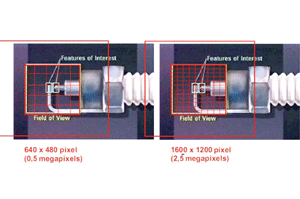
Machine Vision Application
The lens is responsible for creating sufficient image quality to enable the vision system to extract the desired information about the object from the image. It is critical to machine vision performance because information that is not captured by the lens cannot be re-created in software. In a typical application, the lens is required to locate features within the field of view (FOV), ensure the features are in focus, maximise contrast and avoid perspective distortion. What may be adequate image quality for one application may be insufficient for another.
Basics of machine vision optics: The FOV should cover all features that are to be inspected with tolerance for alignment errors. Features within must be large enough to be measured. In alignment and gauging applications, the lens is also responsible for presenting the image in a fixed geometry that is calibrated to the object?s position in space. The working distance (WD) is the distance from the front of the lens to the object. The sensor size is the size of a camera sensor?s active area, typically specified in the horizontal dimension.
The primary magnification is the ratio between the sensor size and FOV. With constant primary magnification, reducing the sensor size reduces the field of view and increasing the sensor size increases it. If the sensor is large enough, it will exceed the size of the image circle that is created by the lens, creating blank spots in the corners of the lens that are known as vignetting.
Resolution: Resolution is a measurement of the vision system?s ability to reproduce object detail. The depth of field (DOF) is the maximum object depth that can be maintained entirely in focus. It also determines the amount of variation in the working distance that can be allowed while still achieving an acceptable focus. But as we move to more powerful sensors, we need to ensure that the optics are able to reproduce the details that we need to image. Targets can be used to determine the limiting resolution of a system and how well the sensor and optics complement each other.
Contrast: Contrast is the separation in intensity between blacks and whites in an image. The greater the difference between a black and a white line, the better the contrast. Colour filtering can be used to increase contrast. Adding either a red or a green filter increases the contrast to the point that the vision solution becomes much more robust.
Diffraction: Diffraction, sometimes called lens blur, reduces the contrast at high spatial frequencies, setting a lower limit on image spot size. The differences between ideal and real lens behaviour are called aberrations. Lens designers choose the geometry of the lens to keep aberrations within acceptable limits and it is impossible to design a lens that works perfectly under all possible conditions. Lenses are generally designed to operate under a specific set of conditions, such as FOV, wavelengths, etc.
Depth of field: DOF is the difference between the closest and furthest working distances an object may be viewed before an unacceptable blur is observed. The F stop number (F/#), also called the aperture setting or the iris setting of the lens helps to determine the depth of field. The F/# is the focal length of the lens divided by the diameter of the lens and are specified for most lenses at a focal length of infinity. As the F/# is reduced, the lens collects less light. The absolute resolution limit of the lens is reduced when the aperture is reduced in size. Reducing the aperture setting or making the aperture smaller increases DOF. Perspective distortion can also be minimised optically with a telecentric lens.
Optics is very important for the overall success of a machine vision application. The examples shown here demonstrate importance of considering the overall system including the optics, lighting and vision system as opposed to simply picking out components. When discussing the application with suppliers, completely explain the goals of the inspection as opposed to just asking for specific components so that the supplier can contribute to the success of the application.
The author is Vice President of International Sales & Marketing at Cognex Corporation, a world leader in machine vision systems.


 +91-22-24193000
+91-22-24193000 Subscriber@ASAPPinfoGlobal.com
Subscriber@ASAPPinfoGlobal.com